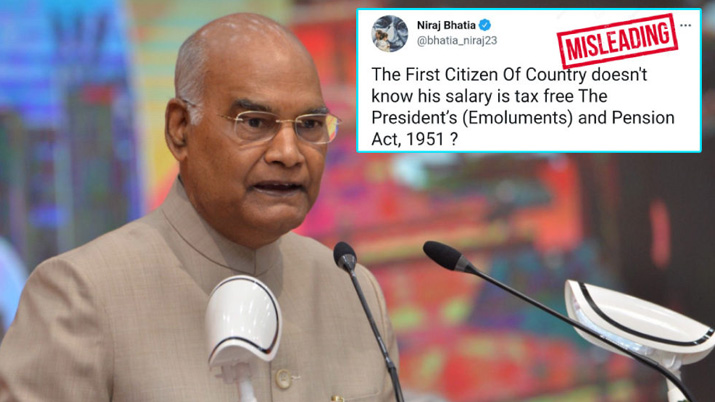The policy of taxation plays a major role in the functioning of the entire country and is one of the key means of earning revenue for the government. The history of paying taxes dates back to centuries. The country has fundamentally two different types of taxes i.e. direct tax which is directly deducted from the income of the taxpayer and is progressive in nature and another is indirect which is distributed through imposing those charges on the commodities. Direct taxes at times are hard to calculate and the taxpayer tends to avoid the payment as due to the progressive nature a lump-sum amount is charged, on the other hand, the indirect tax is paid by every citizen regardless of the class of the community which he/she belongs to.
Evading tax is contemplated as a highly punishable offence in the country. Amid the havoc which Covid has wrecked in the country, to add to more scepticism another news has surfaced according to which, the President of the country is exempted from paying tax. This statement sparked an interesting discussion on the salary and other benefits given to India’s Head of State. People started questioning the position and the privileges enjoyed by the President. Is the President’s salary taxable? If yes, how much tax should he be paying? Does he receive any tax benefits, considering the significance of the office he holds?
President Ram Nath Kovind is in Kanpur on a four-day visit. The President was also involved in a pseudo scenario where people claimed that he bowed down to the Chief Minister of Uttar Pradesh, who happened to be at the site to receive the President and greet him personally.
But before reaching Kanpur, he stirred up a bit of a controversy. Speaking at a public event, he said that while he does earn a healthy salary of Rs 5 lakh a month as President of India, he is not able to save much, as he pays Rs 2.75 lakh as tax every month. He pointed out that, as a result of this, he makes fewer savings than several other officials in positions of public service.
Kovind said, “The President is the highest paid employee of the country, and he also pays taxes. But someone will say that you get five lakh rupees… everyone talks about that. Out of that, every month, quarter to three lakh comes out. So, how much is left? Our officers and others get more than what is left. The teachers who are sitting (at the event), they all get more.”
The President’s (Emoluments And) Pension Act, 1951, lays down provisions for the salary, emoluments, and post-retirement benefits for the person holding the office of the President of India.
The President’s salary is charged from the Consolidated Fund of India. In 2017, the Government of India had decided to increase the salary of The President of India from Rs 1.5 lakh per month to Rs 5 lakh per month.
In addition to the salary, the President receives other allowances, which include free housing and free medical treatment facilities (for life).
As per the reading of section 14 (heads of income) and section 10 (incomes not included in the total income) by various judgments of the Supreme Court, any income which is not specifically exempted from income tax under a law in force is considered to be taxable.
Neither the Income Tax Act nor the President (Emoluments and) Pension Act specifically exempt the salary of the President of India from taxation. Therefore, the President does pay tax on his income. But there is not much clarity on what is the nature of the President’s income is it given as a “salary” or in the form of “income from other sources.”
However, there is one way through which the President can avoid paying income tax. As per the Voluntary Surrender of Salaries (Exemption of Taxation) Act, 1961, if the President chooses to surrender his salary to the Consolidated Fund of India, he would be exempted from taxation.
But this exemption is not restricted to the President of India. Any person, whether their salary comes from the Consolidated Fund of India or not, who chooses to surrender their income to any of the funds administered by the Government of India, is exempted from paying income tax.
Chartered Accountant-turned-lawyer Deepak Joshi tried calculating the tax payable by the President, as per the tax slabs for salaried employees.
He said, “The tax computation for the current financial year for an income of Rs 5 lakh per month comes to about Rs 17.60 lakh annually, translating to Rs 1.47 lakh tax deduction every month, approximately. This calculation assumes that the President has opted for a concessional tax rate regime. But it doesn’t consider any deductions on account of eligible investments & tax concessions, as the same is not in public domain. However, if the President hasn’t opted for the concessional tax rate regime, the tax liability increases to Rs 18.42 lakh, translating to a monthly tax bill of Rs 1.53 lakh approximately.”
“Considering that the monthly tax liability doesn’t add up to Rs 3 lakh, as stated it may be possible that the President had considered the 30 percent pay-cut to arrive at the figure of Rs 3 lakh. A 30 percent pay cut on Rs 5 lakh income means that the President is already getting Rs1.5 lakh less, in hand. The tax liability calculated earlier along with this pay cut tallies the figures provided by the President. This probably was what he intended to convey.”
Also Read:- Is Covovax Ready For Launch In The Country Yet?
Follow us on:- https://www.facebook.com/Fakenewsstudio-101869911543049


